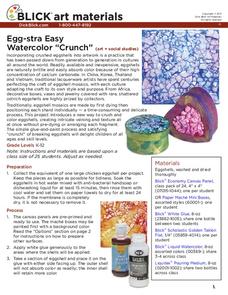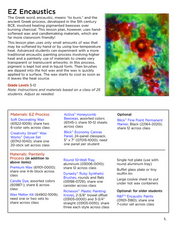Curated OER
Hot and Cold Colors
Students engage in an activity that will allow them to observe that hotter conditions can speed up changes in materials. They will predict whether food coloring disperses more quickly in hot, cold, or room temperature water, and then...
Curated OER
Hot and Cold Colors
Students examine how temperature effects changes in materials. In this physical science lesson, students use food coloring and cups of water of varying temperatures to observe the effects temperature has on matter. Students predict and...
Curated OER
Hot and Cold Colors
Students explore the effect of heating and cooling on the dispersal of food coloring in water.
Curated OER
Colors of Stars
Students observe the colors found in the flame of a burning candle and examine the basic concepts of matter and energy. Students apply this information to the color's of starts and the temperature of the stars photosphere. Students...
Curated OER
Colors Warm And Cool
Students discuss, evaluate, and analyze hot, warm, and cool colors using two Thomas Moran paintings as examples in this Art lesson for K-3rd grade classrooms. The two paintings suggested are "Rock Towers of the Rio Virgin" and "Mountain...
Curated OER
When You're Hot, You're Hot...
Students use the medium of visual arts to demonstrate how colors can evoke different ideas and feelings.
Curated OER
Cool Suits
Young scholars examine the materials that are used to make space suits. They complete an experiment in which they test different materials in different colors to determine the best one for keeping astronauts comfortable. They analyze...
Captain Planet Foundation
Solar Cooking Race
Study heat transfer with activities that focus on how heat energy works. Using a solar cooker, ice cubes, and heat transfer bracelets, kids experiment and record what they find by keeping ice cubes cold and vegetables hot.
Curated OER
Water Cycling in the Wilderness: Alaska quarter reverse
The Alaskan wilderness contains every imaginable element of the water cycle: it has flowing streams, cool spring rain, and frozen glaciers. Pupils use a series of worksheets to identify and define evaporation, condensation, and...
Dick Blick Art Materials
Egg-Stra Easy Watercolor “Crunch”
It doesn't have to be Easter to enjoy this egg-stra fun art project. Kids crunch egg shells, saturate them with color, and glue them to boxes or other objects to make egg-stra special gifts.
Curated OER
The Northern Lights
Sixth graders view photos of Northern Lights and discuss where Northern Lights are usually seen. They examine the colors of light they see and how these colors/lights occur. They use a circular coordinate grid to plot zones of auroral...
Curated OER
The Hertzsprung-Russell Diagram
In this astronomy worksheet, students use a Hertzsprung-Russell diagram to examine the relationship between the average temperatures of stars and their absolute magnitude. After viewing the diagram, they complete 10 short answer questions.
Curated OER
EZ Encaustics
Have your class design a piece of art work using a canvas panel and wax. Learners employ a Greek process of art design popular in the fifth century to create their works. This is a great way to incorporate history into an art lesson.
Curated OER
Juan Bobo Sends the Pig to Mass
Students read the story Juan Bobo Sends the Pig to Mass and complete language arts activities connected to the story. In this language arts lesson plan, 1st graders complete activities including discussion, reading, writing, drawing, and...
Curated OER
Energy
Students are introduced to the concept of energy. After observing a demonstration, they identify the sources of heat and the ways heat can change objects. In groups, they travel between stations to view different demonstrations dealing...
















